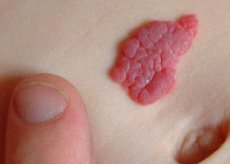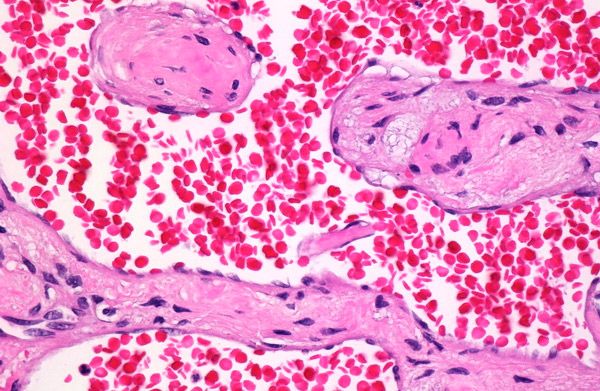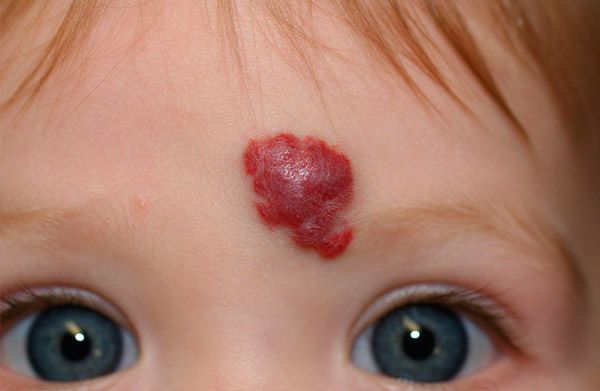Medical expert of the article
New publications
Hemangioma of the skin
Last reviewed: 05.07.2025

All iLive content is medically reviewed or fact checked to ensure as much factual accuracy as possible.
We have strict sourcing guidelines and only link to reputable media sites, academic research institutions and, whenever possible, medically peer reviewed studies. Note that the numbers in parentheses ([1], [2], etc.) are clickable links to these studies.
If you feel that any of our content is inaccurate, out-of-date, or otherwise questionable, please select it and press Ctrl + Enter.

Causes of skin hemangioma
In most cases, a skin hemangioma tumor develops from birth as a result of the proliferation of blood vessels.
 [ 6 ]
[ 6 ]
Pathomorphology
The node consists of a different number of capillaries, sometimes closely adjacent to each other, due to which the tumor acquires a solid structure. In the initial period of growth, the tumor consists of strands of proliferating endothelial cells, in which very narrow lumens can be found in places. In mature foci, the lumens of the capillaries are wider, and the endothelium lining them is flattened. Later, in the regression stage, fibrous tissue grows in the tumor stroma, which compresses and replaces the newly formed capillaries. This leads to wrinkling and complete disappearance of the lesions. Sometimes, vessels of another type, mostly venous, are found among the capillaries. In such cases, such a tumor is called a mixed hemangioma.
Juvenile granuloma occurs in one out of 200 newborns. It appears in the first weeks of a child's life as a red spot that grows, protruding above the skin level. Within 6 months, it reaches its maximum development. The number of lesions varies from single to multiple. Usually, by the age of 6-7 years, the hemangioma has significantly or completely resolved in most patients (70-95%).

Cavernous hemangioma is a limited tumor of normal skin color if deeply located, red with a bluish tint - if the formation is exophytic. The surface of the neoplasm is smooth, but can be lobular with hyperkeratosis or warty. Spontaneous regression of the tumor is observed before puberty, but the course can also be progressive with destruction of adjacent tissues. Cavernous hemangioma can be combined with capillary hemangioma. In some cases, unilateral localization of this tumor is described. In addition, there is a combination with osteolysis (Mafucci syndrome), with thrombocytopenia (Kasabach-Merritt syndrome), as well as a combination of multiple cavernous hemangiomas with dyschondroplasia as a result of an ossification defect, bone fragility, their deformation and the formation of osteochondromas, which can transform into chondrosarcoma (Mafucci syndrome).
There are two types of cavernous hemangioma: with arterial and venous differentiation of the vascular walls.
Hemangioma with arterial differentiation (arterial cavernoma) is less common and occurs mainly in adults. Due to the thick walls of the vessels that form it, it has a livid-blue color. At the same time, a large number of newly formed arterial vessels are found throughout the entire thickness of the dermis. All elements of the vascular wall participate in the process of tumor growth. Hyperplasia of the muscular elements of the vessels, which, however, retain their lumen, is especially pronounced and uneven.
Hemangioma with venous differentiation (venous cavernoma, cavernous hemangioma) is characterized by the presence of large, irregularly shaped cavities in the dermis and subcutaneous tissue, lined with a single layer of flattened endothelial cells, separated from each other by fibrous strands. Sometimes, as a result of the proliferation of adventitial cells, these strands thicken sharply.
Symptoms of skin hemangioma
There are capillary, arterial, arteriovenous and cavernous (juvenile) forms.
Capillary hemangioma is a vascular tumor based on the proliferation of endothelial cells with the formation of capillaries. Clinically, it is characterized by bluish-red or purple spots, sometimes slightly protruding above the surface of the skin, turning pale when pressed. Its variant is stellate angioma in the form of a pinpoint red spot with capillary vessels extending from it. It appears in early childhood (4 to 5 weeks), increases in size up to a year, and then begins to regress, which is observed in 70% of cases, usually up to 7 years of age.

Sometimes capillary hemangioma is combined with thrombocytopenia and purpura (Kasabach-Merritt syndrome).
What do need to examine?
How to examine?

